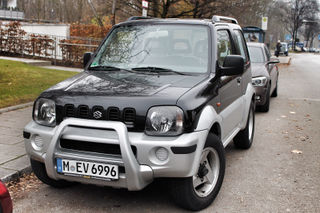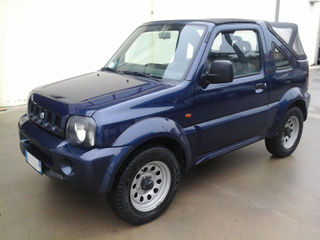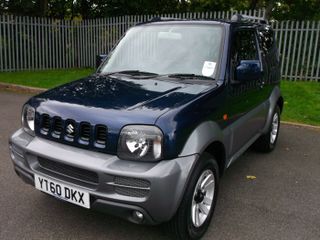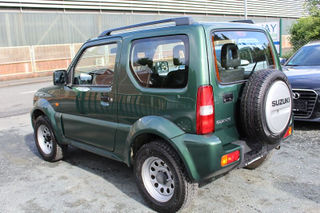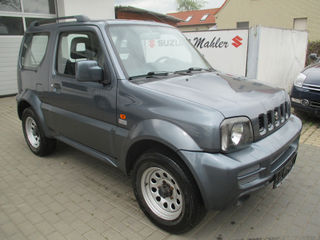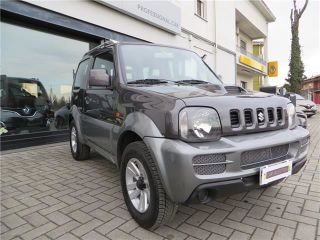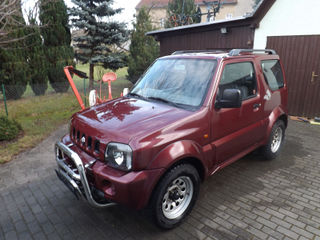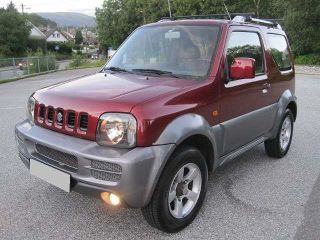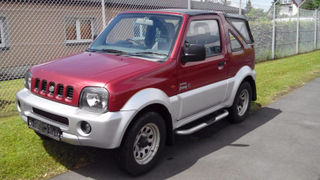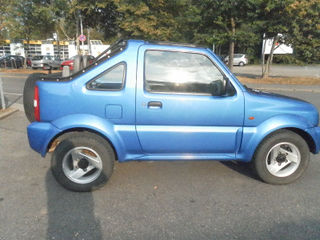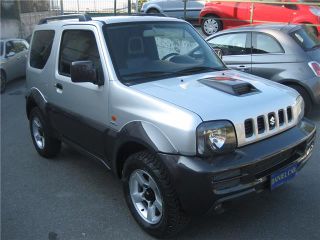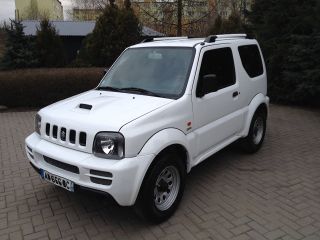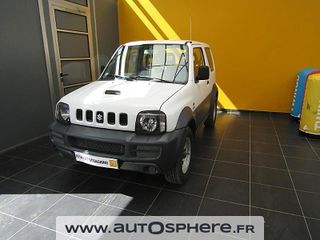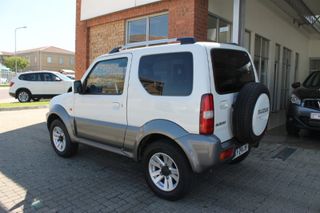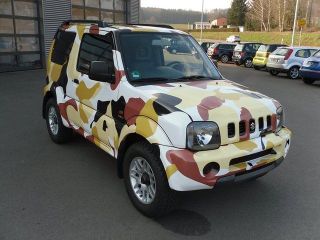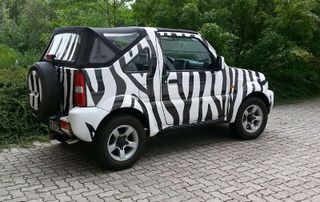![]() The content of any article might be expanded / improved in the future - revisit it sometimes.
The content of any article might be expanded / improved in the future - revisit it sometimes.
![]() Seen a mistake? Know something that isn't written? Edit and change this article yourself!
Seen a mistake? Know something that isn't written? Edit and change this article yourself!
![]() Some images in the article (if present) can be enlarged by clicking on them.
Some images in the article (if present) can be enlarged by clicking on them.
Contents
Introduction
You might have noticed that some Jimnys (and maybe yours too) have two body colors. The typical case is that the plastic side body moldings, as well as the front and rear bumper, have a different color than the main body.
Such dual-tone Jimnys look prettier and more joyful to many people.
That two-tone painting also creates an optical illusion that the vehicle appears larger than it is.
Based on a used car market research in Europe, it appears that Suzuki always used silver, some shade of gray, or plain plastic black color as the secondary color in all of its dual-color Jimny paint schemes.
Examples of factory paints
Enjoy this obscure eye candy. The pictures in each group have been carefully chosen to be as similar as possible, in order to better compare the combinations.
Further enhancements
Introduction
For the sake of this article, for multi-color body paints, we need to name the colors:
- The primary color is the color in which most of the vehicle is painted in (the roof, bonnet, doors).
- The secondary color is the color in which the bumpers, side moldings etc. are painted in.
- The tertiary color (if it exists) is the color in which remaining elements are painted (roof rails, wheel rims, body decals, etc.).
Now, when you get the concept behind dual-color Jimny paints, the idea is to extend this factory dual-paint concept further - to paint some other body elements in the secondary color as well, or to paint them in a tertiary color.
Extending secondary color's presence
Many small body elements could also be in the secondary color as well, giving the car even more diversified look, while staying completely in style of the original two-color design. It would look like a factory design, just further enhanced.
The other recommended body parts to also be in the secondary color are:
- Exterior mirror casings;
- Exterior door handles (all three doors);
- Fuel filler cap lid/cover (metal flap);
- Plastic spare rim cover or plastic/metallic spare wheel cover (if present);
- Bonnet bulge on DDiS Jimnys;
- Vinyl soft top or plastic hard top on cabrio Jimnys;
If the primary and secondary color are quite different, also consider having the plastic door sill moldings in the primary color. (see the "Orange + Silver + Black" picture example below).
Another consideration might be to paint the black parts of the front and rear bumpers into the primary color (each bumper has that black part irrespective of its color).
The entire factory longitudinal roof rails could also be swapped/painted in the secondary color, or just the bar section without the foots.
In some dual-color combinations, painting the wheel rims into the primary color can look really good. In that case, don't forget the spare rim, even if it's usually hidden under a cover!
For post-2012 Jimnys which have separate front grille from the hood, consider having the entire grille in the secondary color, or perhaps paint every odd or even section of the grille in the secondary color.
Examples of extended dual-color bodies
- This picture "Silver + Dark Grey" shows a DDiS Jimny where its bonnet bulge, exterior mirror casings, external door handles and roof rails are also in the secondary color.
- The fuel filler cap is not though, although it might have been a good idea to be as well.
- This is an example of a custom-repainted front grille section on the old (pre-2013) bonnet.
- On pre-2013 Jimnys (like this one), the front grille is a single piece with the bonnet.
- Judge the appeal of the outcome yourself - repainting the front grille on pre-2013 Jimnys like this is not recommended in this article.
Introducing a tertiary color
This is generally a more risky concept than any "extended" dual-color scheme, mostly because many three-color combinations tend to look too flashy and "colorFULLY". However, it might look very nice in certain three-color combinations, but requires careful choice of colors and of which element would be in which color.
Perhaps the tertiary color could be used on the wheel rims, longitudinal roof rails, cabrio soft/hard top, window wiper arms, exterior mirror casings, five small plastic grilles in the bonnet front grille (for pre-2013 Jimnys), black portions of the front and rear bumper, roof box (if fitted), etc.
Examples of triple-color bodies
Here is one three-color example. Judge it for yourself.
How to change the colors
Introduction
You are probably thinking "Well, repaint them, what else". Well first try to think "outside the box"!
First of all, notice that most of the body elements, which are candidates to bear a secondary or tertiary color, are "modular" elements - they either clip on or bolt on to the main body. They are more or less easy to remove and install.
There are two ways to change the color of chosen body elements:
- The obvious method is to repaint them.
- The alternative method is to swap them from another Jimny which has the desired color!
Repainting
Introduction
Although this is the obvious method, an overview of its advantages or disadvantages for this particular case is beneficial.
Advantages
- You can choose any color that you like.
- You can apply special paint protector films (against scratching and chipping) onto the new paint.
- You don't need to mix-and-match parts with anyone.
- If some of your body elements are currently damaged, you can fix the damage on the same occasion.
- Side moldings on the door and wheel arches can usually be painted "on the spot" (without demounting them), saving labor cost and eliminating the risk of breaking the mounting clips.
Disadvantages
- The cost of repainting, especially if done properly. You should best let all the painting be done by a professional vehicle painter.
Swapping parts
Introduction
The method of swapping parts with another vehicle is quite "unorthodox", but could be very rewarding if you succeed.
It is especially rewarding in case of two single-color Jimnys, which would then both become dual-color, just in inverse order. Furthermore, the secondary color in that case does not have to be some shade of silver or gray, as Suzuki has always used as the secondary color.
For example, imagine a single-color light blue Jimny and a single-color blue (or dark blue) Jimny (all those are factory Suzuki colors).
After exchanging the body parts, the first Jimny would get darker bumpers, moldings etc. while the second Jimny would get lighter bumpers, moldings, etc. They would both be unique.
Another example would be a silver Jimny and a grey Jimny. They both look completely bland and ordinary, just as any other ubiquitous silver or grey car today. But after the exchange, both vehicles might get completely transformed into the "fifty shades of grey" trend.
Now imagine all the other color combinations of your liking.
Advantages
The best situation would be if you can find another Jimny owner, whose vehicle's color is your desired secondary color. Then just convince them that your vehicle's color is in fact their desired secondary color :). Perhaps showing them this article might help!
If you manage do to that, you can arrange an almost cost-free body parts exchange deal with them. In that case you would both be happy. The best of all - two Jimnys get colorfully outfitted for a price of none!
If you are confident in (dis)assembling body parts, you don't even need to go to a workshop. Just park two Jimnys together, strip them and refit them. The bumpers might be a bit tricky though when the vehicle is on the ground. Working in a canal would help.
If you can't find a willing Jimny owner to exchange vehicle body parts with you, then search for dead Jimnys in vehicle junkyards. Their willingness to exchange vehicle's body parts with yours' can always be bought with a certain sum of money.
Disadvantages
The only disadvantage with the "parts exchange" method is that if some of the parts (either yours or the others') have visual damage. That could impair the exchange process, because the receiving party won't be so happy to exchange a good part for a scratched or cracked one. But some good will or even money infusion should sort out the situation. It all depends on who is more eager to accomplish the parts exchange deal.
If you manage to arrange this "parts exchange" deal with another owner or with the junk yard, first consider purchasing some body trim clips as a precaution, as those clips are easy to break when removing the side body moldings from the doors, door sills and wheel arches.
Additional notes
Compatibility of parts:
- All the side moldings on the doors, door sills, front wheel arches and rear wheel arches are the same on all Jimny production years.
- The rear bumper is the same as well.
- The front bumper exists in three different generations, but the mounting points should be the same. See more below.
- The external door handles are also the same, as well as the lid of the fuel filler cap.
- The longitudinal roof rails are the same.
- The casings of external mirrors exist in two versions - thinner (older) and thicker (newer). It appears that the change occurred around 2005.
- There are several designs of spare rim covers and spare wheel covers, but they all fit stock size wheels.
- The bonnet bulge from a DDiS Jimny is glued to the bonnet and would have to be forcibly removed - high risk of damage. It's better to buy the entire bonnet with the bulge and repaint them.
- The bonnet bulge from a post-2012 petrol Jimny is mostly a die-cast single piece with the bonnet, apart from its front end section.
- The vinyl soft top, as well as plastic hard top of cabrio Jimnys are the same for all Jimnys (unconfirmed !!)
![]() If your Jimny has a 2nd gen. front bumper, definitely consider changing it for a 1st gen. front bumper on this occasion. You might even consider changing a 3rd gen. front bumper for a 1st gen. front bumper.
If your Jimny has a 2nd gen. front bumper, definitely consider changing it for a 1st gen. front bumper on this occasion. You might even consider changing a 3rd gen. front bumper for a 1st gen. front bumper.
![]() See wiki article "Front bumper issues" for all the details on front bumpers.
See wiki article "Front bumper issues" for all the details on front bumpers.
If you are interested in a certain color from another Jimny as your secondary color, but are not certain how it would look on your car, there is a simple test (apart from parking the cars next to each other!). Replace the fuel filler lids/covers just for a quick visual test. Those covers are dead simple to demount and mount in the middle of a parking lot in just 10 seconds with a simple tool.
Final words
There are so many other combinations and ideas which can not be covered.
But now you at least have a basis for thinking and day-dreaming.
- Just don't get yourself carried away this much!
Page last edited on 2/02/2017 by user Bosanek



